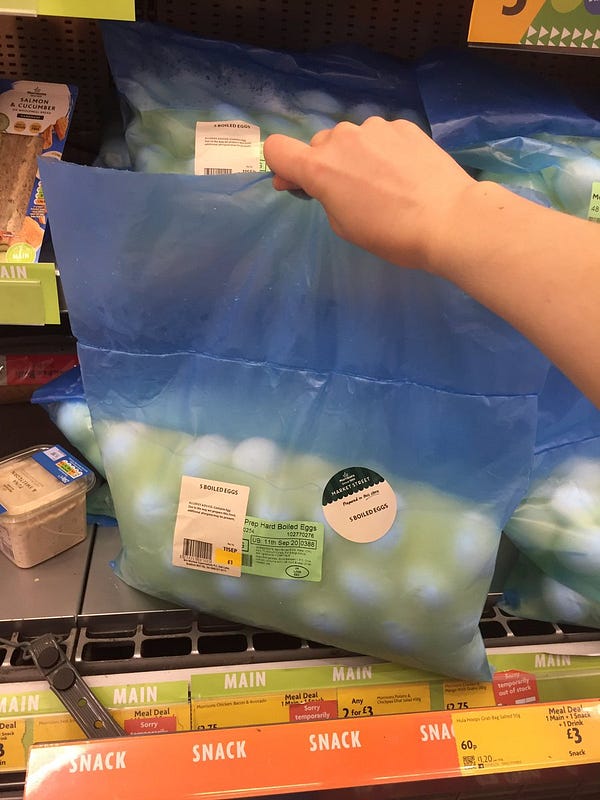Once more, with feeling: Please take a couple minutes and fill out our Sunshine + Microbes 1-year anniversary survey. It’s short and anonymous, so you can really spill the beans! Thank you! 🔥
If someone shared this newsletter with you, subscribe below.

I inherited an exceptionally pristine lawn with my new-to-me house. It has golf course turfgrass that has been strenuously maintained. Basically every new visitor comments on it. A roofer recently told me I had the nicest yard he’d ever seen.
But in my heart of hearts, I would love nothing more than to rip out every inch of that oppressively perfect lawn. When someone tells me how nice the grass is, I do a silent evil laugh and fantasize about my grass-free future in which my yard is lush with shady fruit trees and other perennial, Florida-friendly crops and abuzz with happy pollinators.
A carefully manicured lawn has become the ultimate status symbol for an American Dream achieved. However, I stand firm that grass is terrible for many reasons. It’s the landscaping equivalent of a Stepford wife — vacant, conformist, and sneakily destructive. Grass is the most grown crop in the United States. It is incredibly time and resource-intensive to maintain. Why are we giving so much to a plant that has no practical value besides being nice to sit on? If we’re going to dedicate our lives to maintaining a crop, shouldn’t it at least be a delicious one?
My main beef with lawns is environmental (surprise!). Lawns are a monoculture — meaning a concentration of just one plant. A single type of grass seed is densely planted. Any aberrant weed species is eliminated through the application of weed killers. The lawn and its lack of diversity is unnatural (nature’s de facto state is one of abundance) and requires serious human intervention to maintain. All the water and chemicals needed for lawn maintenance put stress on our fragile environment. The chemicals end up in the water supply and the fuel for mowers turns into more CO2. And it just wastes a ton of water.
Besides the environmental impact, I also have conceptual objections to the American lawn. Is a perfectly uniform landscape that excludes any type of diversity really the symbol we want for our nation? This weirdo doth protest!
But ripping out all the grass around my house will be expensive. Replacing it with a more environmentally appropriate polyculture landscape will take a lot of planning (and a lot of digging). I’m planning to take it slow, first making some changes on how I take care of my lawn, then replacing it section by section. Next week, I’ll be talking about some of those alternatives, from Florida-friendly landscapes to simple tweaks to your lawn maintenance regime.
love,
Jackie
Stop mowing and start growing. Tell your friends about the family:

A Wrap on Summer Workshops
Thank you all for your contributions!
Susan Cartiglia of Radiate Kombucha hosted our final Grow Roots Miami workshop — on making her signature rainbow kraut. Thanks so much to everyone who participated! Grow Roots Miami is soooo close to reaching their fundraising target.
We’re in the process of uploading all of the videos to our YouTube account. Watch and subscribe!
Also, make sure you follow us on Instagram for announcements about other upcoming workshops. Email us (sunshineandmicrobes@gmail.com) with ferments and recipes you’d like to see us cover!
-Jackie
Fresh Links
🚒They Know How to Prevent Megafires. Why Won’t Anybody Listen? | ProPublica
California spends an absurd amount of money on fire suppression. And the megafires — as the past few weeks have demonstrated — are only getting worse. Yet fire management experts know there’s an obvious way to stop outbreaks. By starting good fires, better known as controlled burning.
A “good fire”, one that creates burned parcels in forested areas, would create dead ends and dampers for the intense flames sparking up now. Brush and leaves and other flammable debris build up on the forest ground in uninhabitable areas. The perfect plan would be to burn those things up in a controlled setting. Instead, the opposite occurs:
We keep doing overzealous fire suppression across California landscapes where the fire poses little risk to people and structures. As a result, wildland fuels keep building up. At the same time, the climate grows hotter and drier. Then, boom: the inevitable. The wind blows down a power line, or lightning strikes dry grass, and an inferno ensues. This [past] week, we’ve seen both the second- and third-largest fires in California history.
Environmental scientists have been saying for decades that the state needs more controlled burns, yet less of these burns have occurred over the years. In fact, ProPublica reporter Elizabeth Weir notes that “California would need to burn 20 million acres — an area about the size of Maine — to restabilize in terms of fire.” But the push for the state to invest in more controlled burns appears to be growing as megafires consume the West Coast.


🥜A Food Critic’s Pandemic Diet: Ritz Crackers and Peanut Butter | Houston Chronicle
The wonderful James Beard-award winning food critic Allison Cook contemplates the difference six months can make. Not long ago, she explored the delectable food scene in Texas’ largest city: Sri Lankan curries eaten on a banana leaf; gooseneck barnacles shipped from Spain; and of course barbecue. Now, after so long in quarantine, she’s having cravings for Ritz crackers and peanut butter and compulsions for Graham crackers.
I ate Graham crackers for dessert. For breakfast. I ate them as midnight snacks, with a glass of milk, as if I were a child of 8 again. At some point, I started melting Ghirardelli’s chocolate chips (another urgent craving) in the microwave and spreading them over the Graham crackers to make a sort of s’more manqué, as if I were trying to recapture the joys of Brownie Scout cookouts.
Cook has found pleasure in no longer striving to chase the newest, best, fanciest meal in town. She’s not sure if her palate will change when this pandemic is finally over, but she will be: “I’m not sure I appreciated that life fully when I had it; or questioned its validity sufficiently; or that I would let it consume me as much if life ever returns to normal again.”
👀🔥In Oregon, a Year of Political Tumult Extends to Devastating Wildfires | NY Times
As the planet heats up, dangerous levels of ignorance are showing up in a myriad of ways. It’s not just denial about climate science that’s so frustrating. Or that political leaders aren’t taking the necessary measures to stop the fires. It’s also how misinformation makes focusing on the right problems even harder. Climate change is the most important issue facing the planet today and a major contributing factor to these megafires. Yet the victims of these megafires are inventing new enemies, ones that don’t exist.
Officials tried to evacuate Oregon towns in the past weeks, but holdouts remained — fearing rumors circulating on social media that left-wing mobs were behind the fires. They believed that nonexistent “antifa protesters” had started the fires, and they planned to hurt anyone unfamiliar in their territory. One couple, who had been taking photos of the wildfires in Molalla, Ore., were stalked by townspeople who started posting their whereabouts on a Facebook group. One person replied: “Are you kidding me, shoot em”.
Local fire departments and sheriff’s offices tried to stop the flood of rumors, while demanding residents to evacuate. But far too many people remained, vowing to protect their property — while ignoring the threat of the 125,000-acre fire burning just east of town.

Roasted Garlic and Hazelnut Pesto

A lovely pesto to stir into a pot of pasta, schmear on toast, or toss with roasted veggies.
Ingredients and Special Materials
1/2 cup hazelnuts
1 garlic bulb
1/2 cup parmesan, cubed
1/3 cup olive oil, plus additional for roasting garlic
1/2 teaspoon salt
1/2 teaspoon cracked pepper
optional: a few sun-dried tomatoes, rehydrated in hot water; a handful of kalamata olives; a bunch of parsley, stems and all; an anchovy; or some combination thereof
step-by-step
Place hazelnuts on a pan in the oven. Preheat oven to 400°F. Allow hazelnuts to toast for 12-15 minutes while the oven preheats.
Slice off a small section from the pointy top of the garlic bulb off, so that a bit of each clove is exposed. Place garlic on a square of aluminum foil. Rub a bit of olive oil around the bulb, sprinkle some salt, and wrap up tightly in foil. Roast in oven until cloves are soft, about 40 minutes. (Hot tip: go ahead and roast a few cloves at once. They keep in the fridge for a while, and they’re lovely in everything from salad dressing to soup to scrambled eggs). Once roasted, it’s easy to remove the garlic cloves from their papery skin.
In a blender, pulse roasted garlic cloves, hazelnuts, parmesan, salt, pepper, and any optional add-ins. Once blended into a uniform coarse crumble, add olive oil and blend until smooth. Taste and adjust flavor as needed.
To store, pour a thin layer of olive oil on top of the pesto and place, tightly sealed, in fridge. Keeps for several weeks.

What do we want? UNSETTLING TWEETS ABOUT EGGS 🥚
When do we want it? NOW 🍳








Talk to Us
Send in your comments, mailbag questions, recipe mishaps, or cooking tips: sunshineandmicrobes@gmail.com. Also do us a favor and follow us on Facebook and Instagram. Visit our website and cook yourself something nice.
If you enjoyed this email, please share it with others. If someone forwarded this to you, click the button to sign up:
-------------------------------------------------------------------------------------------------
Sunshine + Microbes team
Jackie Vitale is the current Chef-in-Residence at the Robert Rauschenberg Foundation. and co-founder of the Florida Ferment Fest. Her newsletter explores the intersection of food, culture, environment and community.
Matt Levin is a communications specialist at the ACLU of Texas. He edits Sunshine + Microbes and contributes other scraps to each issue.




